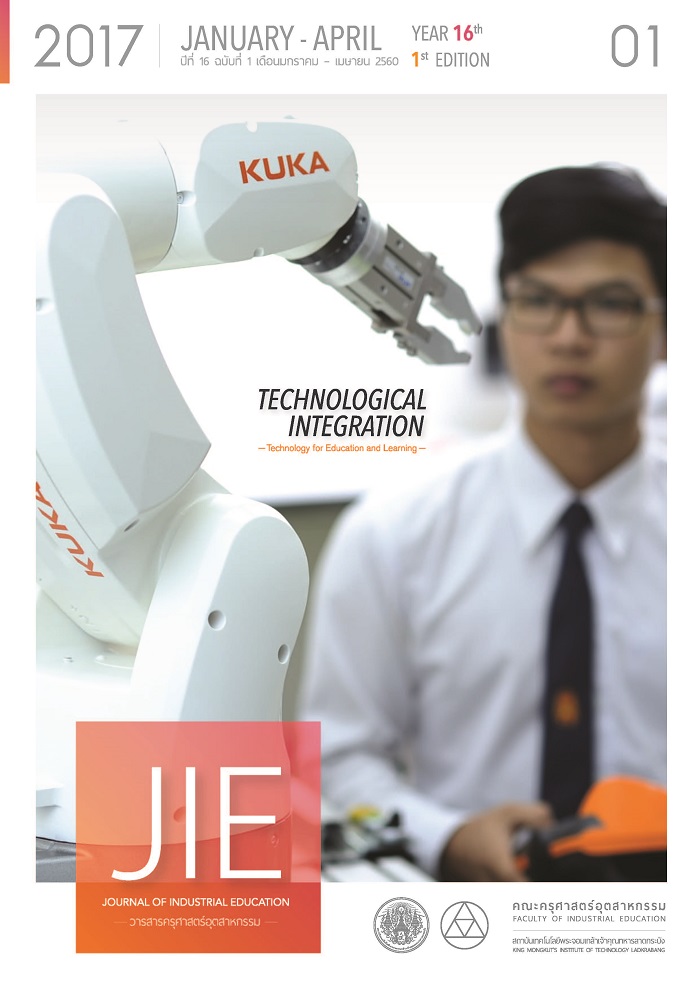การพัฒนาบทเรียนอีเลิร์นนิ่งเรื่อง ข้อมูล ตัวแปร และค่าคงที่ สำหรับนักเรียนชั้นมัธยมศึกษาปีที่ 6
Main Article Content
บทคัดย่อ
การวิจัยครั้งนี้มีวัตถุประสงค์เพื่อ 1) พัฒนาบทเรียนอีเลิร์นนิ่งเรื่อง ข้อมูล ตัวแปรและค่าคงที่ สำหรับนักเรียน ชั้นมัธยมศึกษาปีที่ 6 ที่มีคุณภาพและประสิทธิภาพ 2) เปรียบเทียบผลสัมฤทธิ์ทางการเรียนระหว่างกลุ่มนักเรียนที่เรียนด้วยบทเรียนอีเลิร์นนิ่งกับกลุ่มนักเรียนที่เรียนด้วยวิธีการจัดการเรียนรู้แบบปกติ เรื่อง ข้อมูล ตัวแปรและค่าคงที่ กลุ่มตัวอย่างที่ใช้ในการวิจัย คือ นักเรียนชั้นมัธยมศึกษาปีที่ 6 โรงเรียนวังน้ำเย็นวิทยาคม ภาคเรียนที่ 1 ปีการศึกษา 2558 ได้มาจากการสุ่มตัวอย่างแบบแบ่งกลุ่ม จำนวน 3 ห้อง รวม 110 คน โดยกลุ่มแรกหาประสิทธิภาพเรียนของบทเรียนอีเลิร์นนิ่ง จำนวน 30 คน กลุ่มที่สองเรียนด้วยบทเรียนอีเลิร์นนิ่ง จำนวน 40 คน และกลุ่มที่สามเรียนด้วยวิธีการจัดการเรียนรู้แบบปกติ จำนวน 40 คน เครื่องมือที่ใช้ในการวิจัยครั้งนี้ ประกอบด้วยบทเรียนอีเลิร์นนิ่งเรื่อง ข้อมูล ตัวแปรและค่าคงที่สำหรับนักเรียนชั้นมัธยมศึกษาปีที่ 6 แบบประเมินคุณภาพของบทเรียนอีเลิร์นนิ่ง และแบบทดสอบวัดผลสัมฤทธิ์ทางการเรียน จำนวน 30 ข้อ ซึ่งมีค่า IOC อยู่ระหว่าง 0.67-1.00 ค่าความยากง่ายอยู่ระหว่าง 0.50- 0.73 ค่าอำนาจจำแนกอยู่ระหว่าง 0.20-0.60 และค่าความเชื่อมั่นเท่ากับ 0.85 สถิติที่ใช้ในการวิเคราะห์ข้อมูล ได้แก่ ค่าเฉลี่ย ค่าเบี่ยงเบนมาตรฐาน และสถิติทดสอบค่าทีชนิดสองกลุ่มเป็นอิสระต่อกัน ผลการวิจัยพบว่า
- บทเรียนอีเลิร์นนิ่งเรื่อง ข้อมูล ตัวแปรและค่าคงที่ สำหรับนักเรียนชั้นมัธยมศึกษาปีที่ 6 มีคุณภาพด้านเนื้อหาอยู่ในระดับ ดีมาก (x̄ =4.82, S.D.=0.39) และคุณภาพด้านเทคนิคการผลิตสื่ออยู่ในระดับดีมาก (x̄ =4.83, S.D.=0.38)
- บทเรียนอีเลิร์นนิ่งเรื่อง ข้อมูล ตัวแปรและค่าคงที่ สำหรับนักเรียนชั้นมัธยมศึกษาปีที่ 6 มีประสิทธิภาพ E1/E2 เท่ากับ 82.87/81.56
- ผลสัมฤทธิ์ทางการเรียนของนักเรียนที่เรียนด้วยบทเรียนอีเลิร์นนิ่งสูงกว่านักเรียนที่เรียนด้วยวิธีการจัดการเรียนรู้แบบปกติอย่างมีนัยสำคัญทางสถิติที่ระดับ .01
Article Details
"ข้อคิดเห็น เนื้อหา รวมทั้งการใช้ภาษาในบทความถือเป็นความรับผิดชอบของผู้เขียน"
References
[2] Klaysang Jintawee. 2013. E-Learning Courseware : Concept to practice for e-learning at all levels. 2nded. Bangkok : V.Print (1991).
[3] Laohajarussang Thanom. 2002. Designing e-Learning : Principles of web design and creation for teaching and learning. Bangkok : Arunkanpim.
[4] Ruttanatirakul Arnut. 2010. Install and Manage Windows Web Hosting for Organization. Bangkok : Se-Education.
[5] Muangman Pornthep. 2001. Designing and Development CAI Multimedia with Authorware. Bangkok : Se-Education.
[6] Ritchie,D.C., & Hoffman, B. 1997. Incorporating instructional design principles with the Word Wide Web. In B.H. Khan (ED.) Web-Based Instruction (pp.135-138)
[7] Meearsa Suchira Klinhom Lertlak and Mano Kitipong. 2009. Development of tutorial web based instruction on basic data management entitled data sorting. Journal lf Industrial Education, 8(2), p.11-20.
[8] Brahmawong Chaiyong. 2013. Developmental Testing of Media and Instructional Package. Silpakorn Educational Research Journal, 5(1), 7-20.
[9] Anderson, L. W. and Krathwohl, D. R., et al. 2001. A taxonomy for learning, teaching, and assessing: A revision of Bloom’s Taxonomy of Educational Objectives (Complete edition). New York: Longman.
[10] Penmongkhol Sudarat Pimdee Paitoon and Klinhom Lertlak. 2015. Delvelopment of Web-Base Instruction for Review on Data Communication Computer Network for High School Students. Journal lf Industrial Education, 14(2), 167-173.
[11] Tema Anchalee. 2008. Web-based instruction on chemistry in daily life. Master of Industrial Education, Educational Technology in Vocational and Technical Education, King Mongkut's Institute of Technology Ladkrabang.
[12] Mamath Laddawan. 2011. Web-based instruction on data and information for information and communication technology. Master of Science in Science Education (Computer), King Mongkut's Institute of Technology Ladkrabang.

